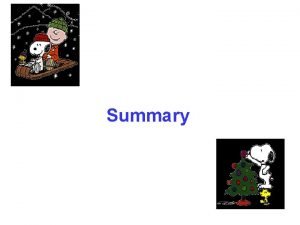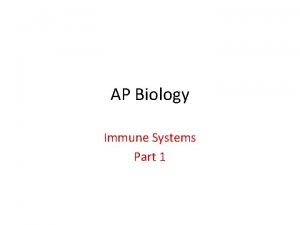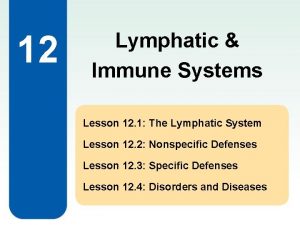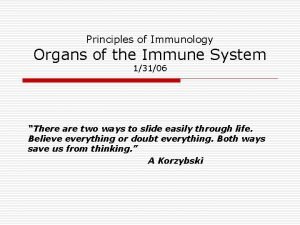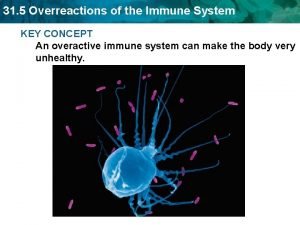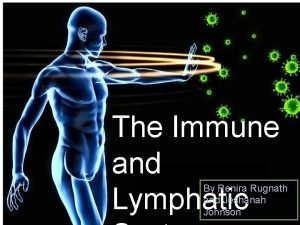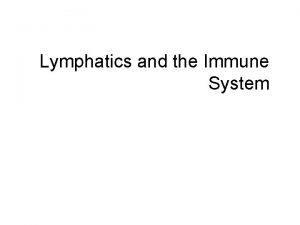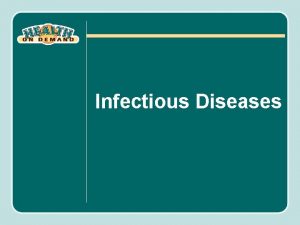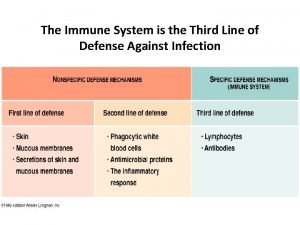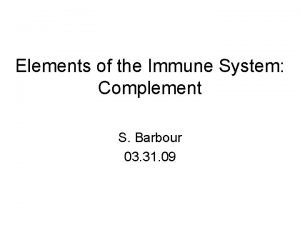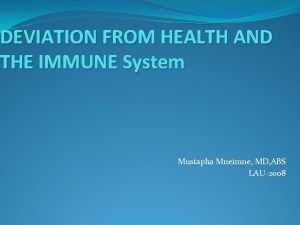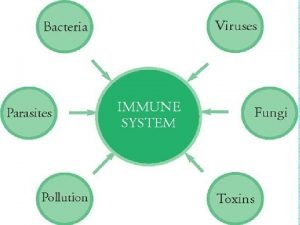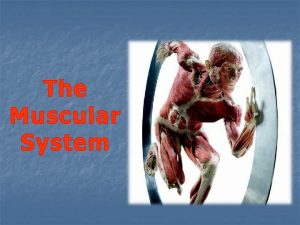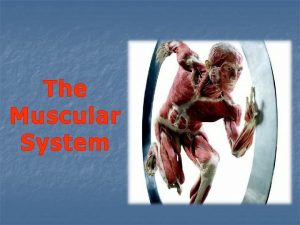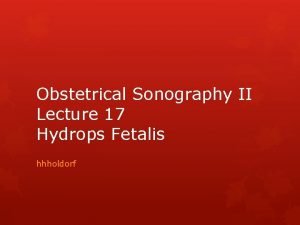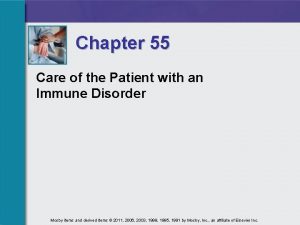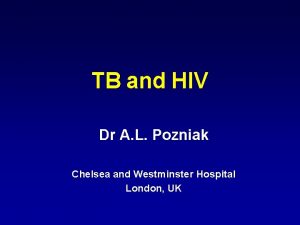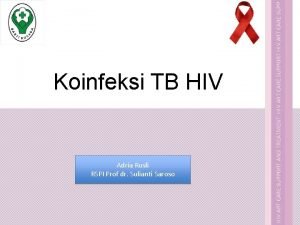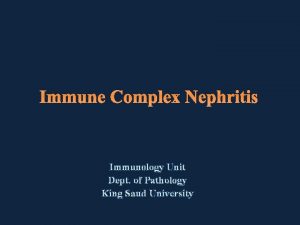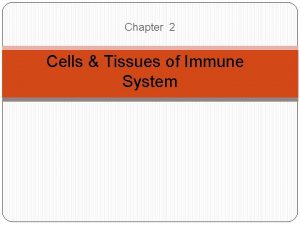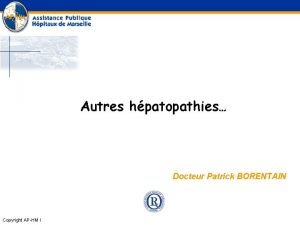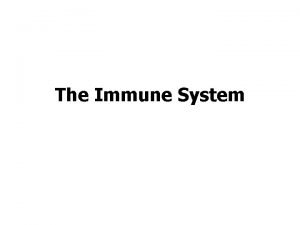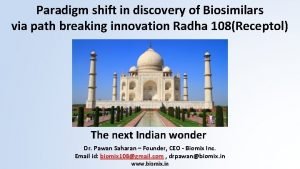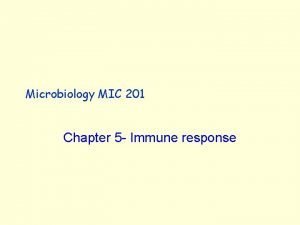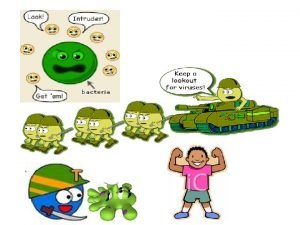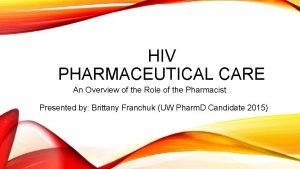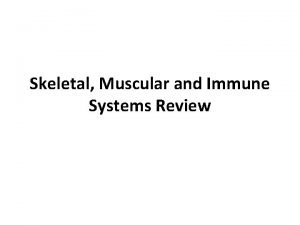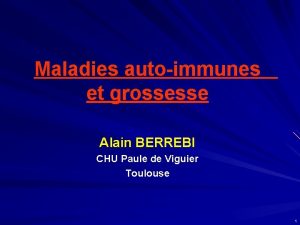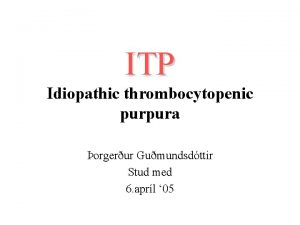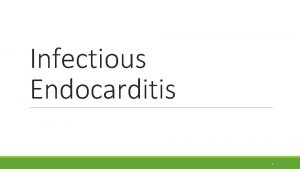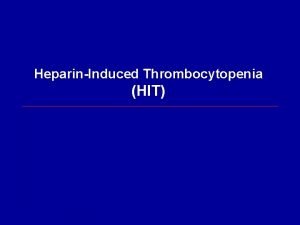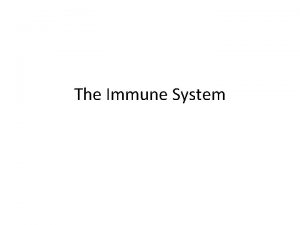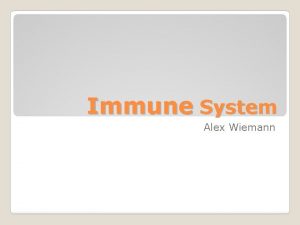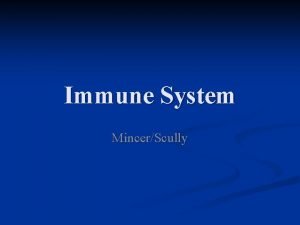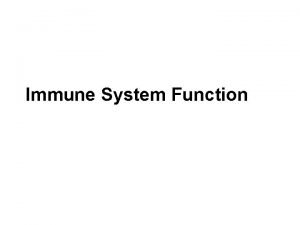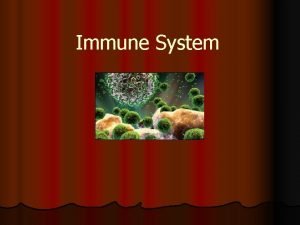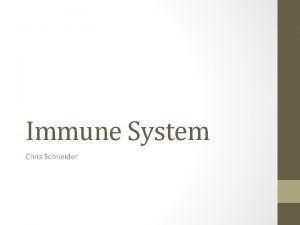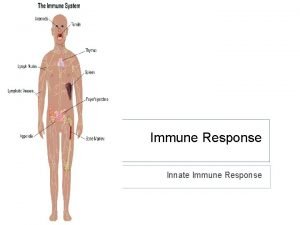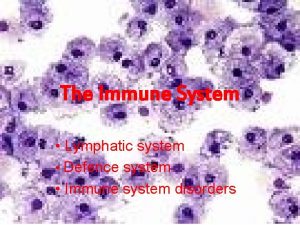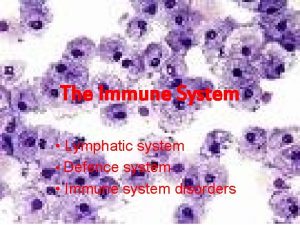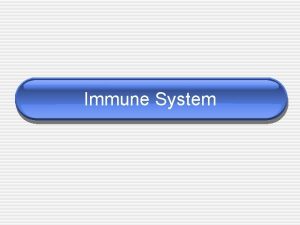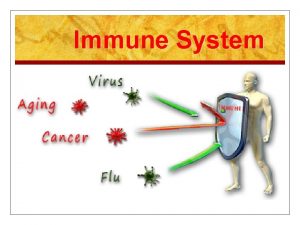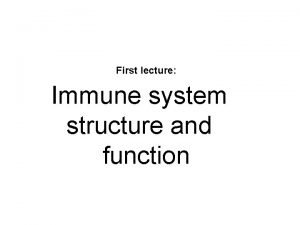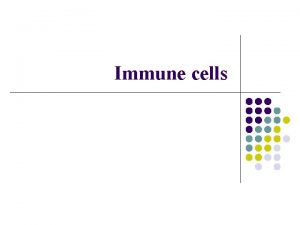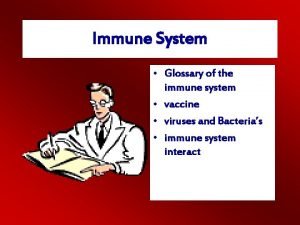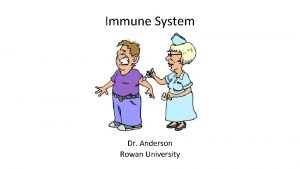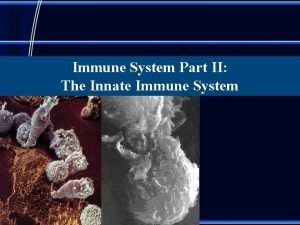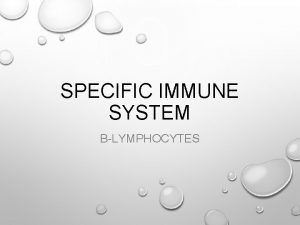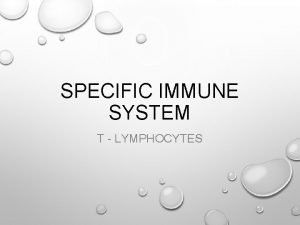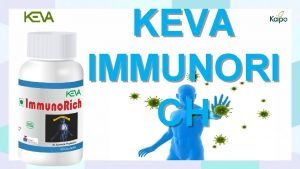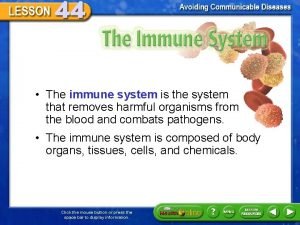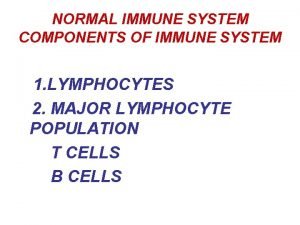1 Whats the function of the immune system
































































- Slides: 64

1

What’s the function of the immune system? • To protect us from: –Foreign substances –pathogens 2

• pathogen: an organism that causes a disease; a germ 3

Types of pathogens Type of pathogen Curable yes/no Name 1 disease in this category Bacteria Virus Fungi Protozoan parasites Yes No Yes Yes Malaria tapeworm 4

How do viruses and bacteria attack organisms? • Our cells have receptors on them 5

• Viruses and bacteria have protein molecules on them called antigens that must match the antigens shape of the receptors on our cells 6

7

• As long as the bacteria or virus shape matches the shape on our cell receptors, then it will attach to our cells and make us SICK!!!!!! 8

• The relationship between a virus and human OR a bacteria and human is called a pathogen/host relationship 9

• Sometimes viruses and bacteria can change the shape of their antigens so they can infect the human cell • What causes this change to occur in the virus or bacteria? • A mutation 10

11

Components of the immune system: • 1. Bone marrow produces new red and white blood cells. • 2. The complement proteins are activated by and work with the antibodies to attack germs 12

13

• 3. interferon prevents viral replication in the cell and also stimulates killer T-cells. Interferon is the main anti-viral defense of the body • 4. Lymph nodes are basically filters that trap germs and other foreign bodies 14

15

• 5. The spleen filters the blood looking foreign cells 16

• 6. The thymus is responsible for producing Tcells and is important for T cell maturation 17

• 7. Antibodies are produced by white blood cells. • Antibodies can bind to toxins, disabling their chemical actions or signal that an invader needs to be removed 18

• 8. There actually a large collection of different white blood cells that work together to destroy bacteria and viruses. 19

Types of white blood cells • • Leukocytes Lymphocyte Monocytes Granulocytes Phagocytes Plasma cells T-cells Helper T-cells • • Killer T-cells Suppressor T-cells Natural killer cells B cells Eosinophils Basophils Neutrophils Macrophages 20

Why aren’t we sick EVERYDAY? ? ? • The body has physical AND chemical barriers to protect us • These are called the body’s first line of defense 21

The body’s line of defense • 1. the skin • 2. tears and saliva • 3. mucous membranes in your mouth, nose and bronchial tubes • 4. cilia in the respiratory tract • 5. gastric juices in the stomach 22

• How does the body fight pathogens when they enter? • The body will trigger an immune response 23

The immune response • the helper T cells 24

• The helper T cells trigger the production of B cells and killer T cells 25

Phagocytes • The phagocytes engulf the pathogens • This process is called phagocytosis 26

27

• Killer T cells {cytotoxic T cell} 28

• The killer T cells attack and destroy infected body cells • Killer T cells don’t attack the pathogens themselves, only the infected cells 29

• The B cells produce antibodies and memory cells • Antibodies attach to the antigens of the pathogens 30

31

• Then the antibodies either attack the pathogen or mark them for destruction by white blood cells to engulf • Antibodies must match the shape of the antigen on the pathogen in order to work 32

• There are specific antibodies to kill specific pathogens • After the pathogens are killed, memory cells and antibodies are left in the body to protect us from the same specific pathogen in the future 33

• This gives us immunity to that particular disease 34

The final step of the immune response • Suppressor T cells coordinate the activities of other T cells • They “turn off” the helper T cells, killer T cells, the phagocytes and the B cells when the infection has been cleared 35

36

Types of immunity • 1. innate: the type of immunity that is present at birth and passed down genetically from parents to children. 37

• 2. active immunity: when your body produces its own antibodies – Naturally acquired active immunity develops when your body is exposed to antigens from invading pathogens – Artificially acquired active immunity develops in response to a vaccine 38

• 3. passive immunity: receiving antibodies from another person or animal – Natural passive immunity occurs when antibodies pass from mother to child during pregnancy or while nursing – Artificial passive immunity results from the injection of antibodies produced by an animal or a human who is immune to the disease 39

• Name some strategies that will help reduce your risk of getting or spreading communicable diseases 40

vaccines • Identify the substance in a vaccine • dead/weakened pathogen • antigens • a small piece of the virus/viral coat 41

vaccines • Describe how the body responds to vaccines • The vaccine stimulates the immune system to produce antibodies. • https: //youtu. be/Wn. Br. P-Gfj. M 4 42

43

44

What is a disease? • A disease is a disturbance in homeostasis 45

Causes of diseases • Heredity • Toxins • Poor nutrition • Direct Contact • Organ malfunction • Personal behaviors • Gene mutation • Indirect contact • airbourne 46

Immune system diseases • 1. AIDS • Disease caused by the HIV virus that damages the immune system 47

• 2. Allergies • When the immune system responds to usually harmless environmental substances such as: • Pollen • Certain foods • chemicals 48

• 3. the immune system attacks transplanted organs because the transplanted organs have foreign antigens on them • 4. autoimmune diseases: when the immune system attacks some of the body’s own cells 49

Autoimmune disease Most common types • Rheumatoid arthritis: A chronic inflammatory disorder affecting many joints, including those in the hands and feet. • Type 1 diabetes: A chronic condition in which the pancreas produces little or no insulin. • Multiple sclerosis: A disease in which the immune system eats away at the protective covering of nerves. 50

• Vasculitis: An inflammation of the blood vessels that causes changes in the blood vessel walls. • Alopecia areata: Sudden hair loss that starts with one or more circular bald patches that may overlap. • Lupus: An inflammatory disease caused when the immune system attacks its own tissues. 51

• Polymyalgia rheumatica: An inflammatory disorder causing muscle pain and stiffness around the shoulders and hips. • Ankylosing spondylitis: An inflammatory arthritis affecting the spine and large joints. • Temporal arteritis: An inflammation of blood vessels, called arteries, in and around the scalp. 52

• Sjögren's syndrome: An immune system disorder characterized by dry eyes and dry mouth. • Celiac disease: An immune reaction to eating gluten, a protein found in wheat, barley, and rye. 53

Terminology • Sporadic: occasional cases • Endemic: constantly present 54

• Epidemic: a spread of a disease in ONE area • Pandemic: a WORLD-WIDE spread of a disease 55

• Host: An organism that is infected with or is fed upon by a parasitic or pathogenic organism • Reservoir: a source of the pathogen in the environment [examples] – Humans – Animals – Inanimate objects 56

• Vector: animals such as mosquitoes, flies, ticks, fleas and lice that transmit diseases from one living thing to another • fomite: is any object or substance capable of carrying infectious organisms and transferring them from one individual to another. 57

• Emerging infection: An infectious disease that has newly appeared in a population or that has been gone for some time but is rapidly increasing in incidence or geographic range. 58

• Epidemiology: The study of an illness 59

Prevalence: the number of times an illness occurs 60

• Morbidity: ratio of sick people • Mortality rate: the number of people who died from a disease 61

62

• The US agency charged with tracking and investigating public health trends. • The stated mission of the Centers for Disease Control and Prevention, commonly called the CDC, is "To promote health and quality of life by preventing and controlling disease, injury, and disability. " 63

64
 Primary immune response and secondary immune response
Primary immune response and secondary immune response Main function of the immune system
Main function of the immune system What is the third line of defense in the immune system
What is the third line of defense in the immune system Immune system flow chart
Immune system flow chart Third line of defense immune system
Third line of defense immune system Innate immunity first line of defense
Innate immunity first line of defense Chapter 35 immune system and disease
Chapter 35 immune system and disease 1st 2nd and 3rd line of defense immune system
1st 2nd and 3rd line of defense immune system Ap bio immune system
Ap bio immune system Lesson 12 blood and immune system
Lesson 12 blood and immune system Lesson 12 blood and immune system
Lesson 12 blood and immune system Oobean
Oobean Immune system def
Immune system def Overreactions of the immune system
Overreactions of the immune system Lymphatic vs immune system
Lymphatic vs immune system Phagocitize
Phagocitize Defination of infection
Defination of infection First line of defense
First line of defense Lingual tonsil
Lingual tonsil Thymus
Thymus Mac immune system
Mac immune system Thalassemia facies
Thalassemia facies 1what's the purpose of the body's immune system?
1what's the purpose of the body's immune system? Primary functions of muscular system
Primary functions of muscular system Muscular system primary function
Muscular system primary function Whats the main function of the skeletal system
Whats the main function of the skeletal system Spalding sign
Spalding sign Primary vs secondary immune response
Primary vs secondary immune response Chapter 55 care of the patient with an immune disorder
Chapter 55 care of the patient with an immune disorder Chapter 24 the immune and lymphatic systems and cancer
Chapter 24 the immune and lymphatic systems and cancer Cancer vaccines
Cancer vaccines Immune reconstitution inflammatory syndrome
Immune reconstitution inflammatory syndrome Predeksihkhariini
Predeksihkhariini Immune complex glomerulonephritis
Immune complex glomerulonephritis Immune effector cells
Immune effector cells Primary immune response
Primary immune response Immune effector cells
Immune effector cells Immune response controller crossword
Immune response controller crossword Hepatite auto immune fmc
Hepatite auto immune fmc Immune defintion
Immune defintion Lupus
Lupus Primary and secondary immune response
Primary and secondary immune response Biosimilar study
Biosimilar study Ctl
Ctl Passive vs active immunity
Passive vs active immunity The lymphatic capillaries are
The lymphatic capillaries are Immunity assignment slideshare
Immunity assignment slideshare Immune reconstitution therapy
Immune reconstitution therapy Type of muscle
Type of muscle Maladie auto immune connectivite
Maladie auto immune connectivite Immune thrombocytopenic purpura
Immune thrombocytopenic purpura Immune complex
Immune complex Heparin induced thrombocytopenia
Heparin induced thrombocytopenia Hlab53
Hlab53 Whats hot whats not
Whats hot whats not Hát kết hợp bộ gõ cơ thể
Hát kết hợp bộ gõ cơ thể Ng-html
Ng-html Bổ thể
Bổ thể Tỉ lệ cơ thể trẻ em
Tỉ lệ cơ thể trẻ em Chó sói
Chó sói Tư thế worms-breton
Tư thế worms-breton Hát lên người ơi alleluia
Hát lên người ơi alleluia Môn thể thao bắt đầu bằng từ chạy
Môn thể thao bắt đầu bằng từ chạy Thế nào là hệ số cao nhất
Thế nào là hệ số cao nhất Các châu lục và đại dương trên thế giới
Các châu lục và đại dương trên thế giới

